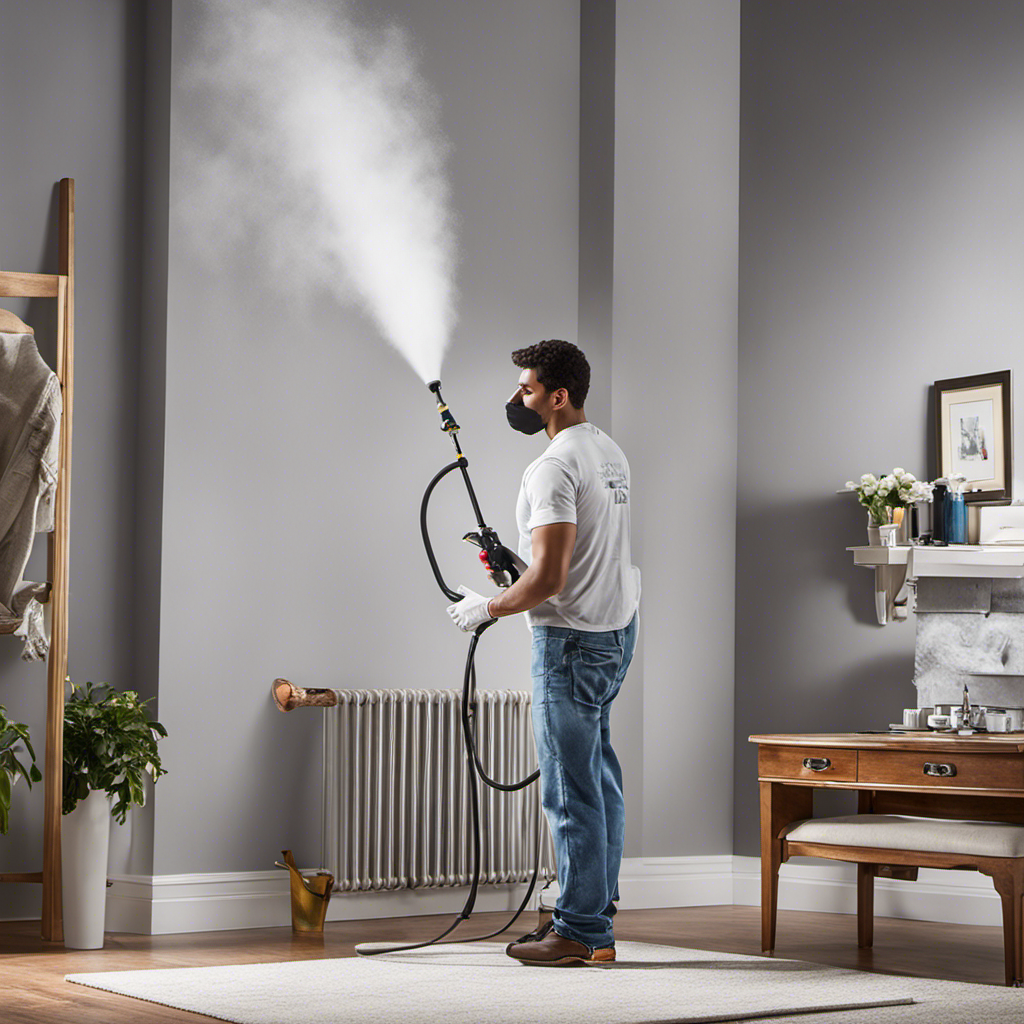To spray window sashes and grilles, start by thoroughly cleaning the surfaces to guarantee proper adhesion. Mask off glass, hardware, and nearby areas with painter’s tape and drop cloths. Use light, even coats of primer if needed, then spray with smooth, overlapping strokes, maintaining a consistent distance from the surface. Allow the paint to cure fully before handling. Want more tips to perfect your finish? Keep exploring for detailed techniques, tools, and best practices.
Key Takeaways
- Cover glass, hardware, and surrounding areas with painter’s tape or drop cloths to protect from overspray.
- Use high-quality primer suitable for the surface material and apply in light, even coats before painting.
- Hold the spray gun 6-12 inches from the surface, overlapping strokes slightly for uniform coverage.
- Spray grille details and moldings carefully to ensure smooth, even finish with consistent distance and technique.
- Allow proper curing time according to manufacturer’s instructions before handling or reinstalling the window sashes.

Spraying window sashes and grilles is an effective way to refresh their appearance and protect them from the elements. When you decide to update or restore your window frames, proper preparation is key. Start by thoroughly cleaning the surfaces to remove dirt, dust, and old paint residue. Use a mild detergent and a scrub brush or a sponge, then rinse with water and let everything dry completely. This step is essential for good window frame maintenance because it guarantees the new paint or finish adheres properly and lasts longer. Skipping this step can lead to peeling or uneven coverage later on.
Thorough cleaning ensures proper paint adhesion and longer-lasting window frame finishes.
Next, you’ll want to inspect the window sashes and grilles closely. Look for any signs of damage, such as cracks, rot, or peeling paint. Repair these issues before spraying by filling cracks with wood filler and sanding smooth. Sanding is especially important because it creates a rough surface that promotes better paint adhesion tips. Use fine-grit sandpaper to gently scuff the surfaces, focusing on areas where old paint is flaking or peeling. After sanding, wipe away any dust with a tack cloth or a damp rag to ensure a clean surface for spraying.
When you’re ready to spray, choose a high-quality primer suited for your window material—wood, metal, or vinyl. Applying a primer helps improve paint adhesion, prevents bleed-through, and offers an even base for your finish coat. Follow the manufacturer’s instructions for drying times before applying the paint or finish coat. For the best results, use light, even coats, holding the spray gun at a consistent distance from the surface—usually about 6-12 inches. Keep your strokes smooth and overlapping slightly to avoid drips or runs.
During spraying, pay special attention to the window frame maintenance details. Make sure to cover glass panes, hardware, and adjacent surfaces with painter’s tape or drop cloths to prevent overspray. Proper masking not only helps achieve a clean, professional look but also minimizes cleanup afterward. When spraying grille details or intricate moldings, take your time to ensure all areas are evenly coated. Additionally, understanding the benefits of surface preparation can significantly improve the durability and appearance of your finish.
After finishing, allow the paint to cure fully according to the manufacturer’s instructions before handling or reinstalling window sashes. Regular maintenance, like cleaning and touch-up painting when needed, will keep your window frames looking fresh and protected for years. Remember, good surface preparation combined with proper application techniques and paint adhesion tips makes all the difference in achieving a durable, smooth finish that enhances your home’s curb appeal.
Frequently Asked Questions
What Type of Paint Is Best for Spraying Window Sashes?
You should use a high-quality, oil-based or latex-based paint designed for trim and windows. Before spraying, focus on proper paint preparation by stirring thoroughly and thinning slightly if needed. Use smooth brush techniques to remove drips or uneven spots. This guarantees a clean, even finish. Always choose a paint that adheres well and dries smoothly, making your spraying process easier and resulting in professional-looking window sashes.
How Do I Prevent Paint Drips During Spraying?
To prevent paint drips while spraying, keep your spray gun at a consistent distance and use smooth, even strokes. Don’t overload the gun with paint, as this causes drips. Allow sufficient paint drying times between coats, and maintain your spray gun regularly for smooth spray patterns. Proper spray gun maintenance helps prevent splatters and drips, ensuring a professional finish. Practice on scrap surfaces before starting your project for best results.
Can I Spray Over Old Paint Without Sanding?
You can spray over old paint without sanding if the existing surface has good paint adhesion and is clean. First, thoroughly clean the surface to remove dirt, grease, and loose paint. Lightly sand any glossy areas to improve adhesion, then apply a suitable primer if needed. This surface prep guarantees your new coat sticks well, providing a smooth finish without the need for extensive sanding.
How Long Should I Wait Between Coats?
You should wait at least 2-4 hours between coats, depending on your paint’s drying time and the room’s conditions. Check the manufacturer’s recoating interval on the label for best results. Make sure the previous coat feels dry to the touch and isn’t tacky before applying the next. Rushing this step can cause uneven finishes or peeling, so patience guarantees a smooth, durable finish.
What Safety Gear Is Recommended for Spraying?
Think of your safety gear as your armor in a battle. You should wear personal protective equipment like gloves, goggles, and a mask to shield your face and lungs. For spray gun safety, make certain your respirator is fitted correctly and your gloves are resistant to chemicals. Long sleeves and a hat also help protect your skin. Always follow manufacturer instructions to keep your spraying experience safe and effective, turning you into a true craftsman.
Conclusion
Now that you know how to spray your window sashes and grilles, you’ll transform your windows from dull and tired to stunning masterpieces that could rival a gallery display. Just imagine your home shining brighter than a diamond in the sunlight, all thanks to your handy skills. With patience and the right techniques, you’ll achieve a flawless finish that makes your windows look brand new. Get ready to wow everyone with your incredible DIY prowess!
Franz came aboard the Paint Sprayer Zone team with a background in both journalism and home renovation. His articulate writing style, combined with a passion for DIY projects, makes him an invaluable asset. Franz has a knack for breaking down technical jargon into easy-to-understand content, ensuring that even the most novice of readers can grasp the complexities of paint sprayers.










